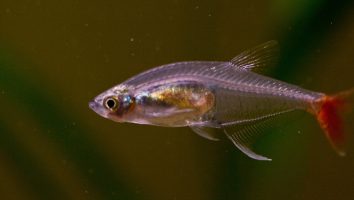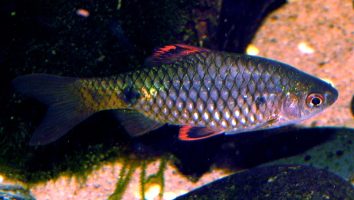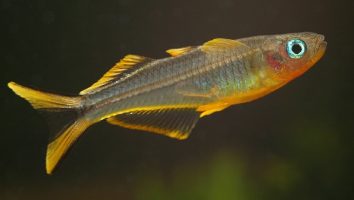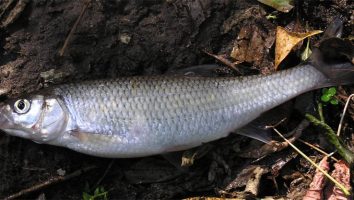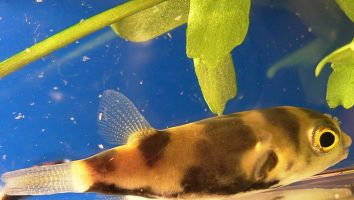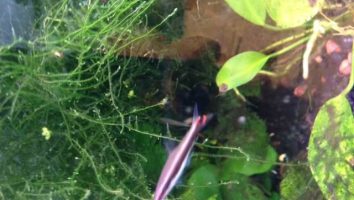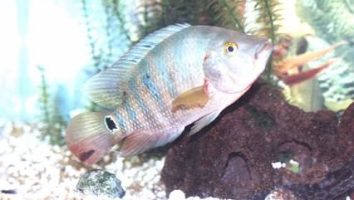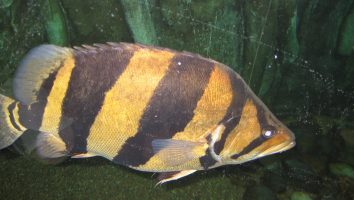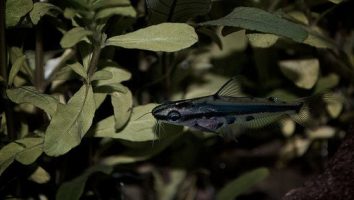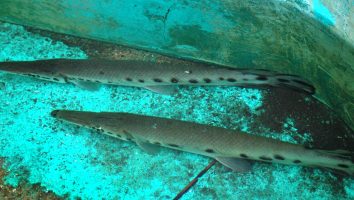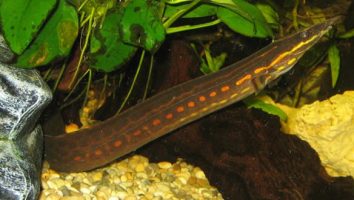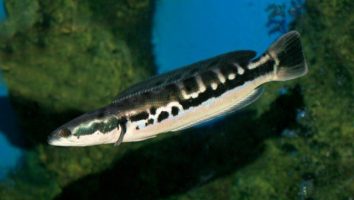The orangespotted sunfish is a beautiful and unique freshwater fish that is perfect for the beginner aquarist. They are hardy and can tolerate a wide range of water conditions, making them a great choice for those just starting out.
This guide will teach you everything you need to know about orangespotted sunfish care. You’ll learn about their diet, size, lifespan, and more!
Table of contents
Species overview
Orangespotted sunfish (Lepomis humilis) are a small freshwater fish that are found throughout the Midwestern United States.
They prefer habitats with plenty of vegetation, such as marshes, ponds, and lakes. This is something to keep in mind if you’re planning on keeping them in an aquarium since they’ll need plenty of plants to hide in.
Orangespotted sunfish are relatively easy to care for and make a great choice for beginner aquarium enthusiasts. They are peaceful fish that get along well with other tank mates and are not known to be aggressive.
One of the most notable features of the orangespotted sunfish is their bright orange spots. These spots are what give this fish its name and are one of the main reasons why it’s such a popular choice for aquariums.
Appearance

As the name suggests, this species has spots that are orange in color. However, there are also specimens that have yellow spots or a mix of the two. These spots are pretty small and are located all over their body.
The base color of their body is a light blue that can look almost white in certain lighting. The underside of the fish is usually a little bit lighter in color.
Orangespotted sunfish have a very distinct body shape that’s a little hard to describe. They’re long and thin, but they have a lot of curves and ridges running along their body.
The dorsal and anal fins on this fish are both tall and thin. They start about two-thirds of the way back on the body and extend almost to the end of the fish.
The caudal fin is forked and symmetrical. The ventral fins are small and begin just behind the gill plate.
Orangespotted sunfish have a small mouth that’s located at the end of a slightly protruding snout. They have large eyes that sit fairly far back on their head.
Lifespan
The average lifespan of orangespotted sunfish is around 4 years. However, there are a number of factors that can impact their life expectancy.
For starters, if these fish haven’t reproduced then their lifespan will usually be on the higher side of this range. That process can really take a toll on the fish.
The general level of care they receive obviously matters a great deal as well. Even though these are very hardy fish, they’ll obviously live longer in optimal conditions.
Size
Orangespotted sunfish generally range in size from 4-6 inches.
Tank
Tank Size
The recommended tank size for orangespotted sunfish is at least 20 gallons. If you’re looking to keep a school of these fish, you should add an additional 10 gallons for each fish you add to the tank.
While 20 gallons is the minimum, we recommend a larger tank if you have the room. These fish are very active and need a lot of space to swim. A larger tank will also allow you to keep more fish if you’re looking to create a community tank.
Water Parameters
As with all fish, the orangespotted sunfish needs water that’s clean and well-oxygenated. They also prefer slightly alkaline water with a moderate hardness.
The water temperature can vary quite a bit, but they prefer water that’s on the cooler side. In the wild, they’re often found in spring-fed streams with water temperatures in the 60s.
Here are some basic water parameters to help create a healthy orangespotted sunfish environment.
- Water temperature: 60 to 80 degrees Fahrenheit
- pH levels: 7.0 to 8.0
- Water hardness: 4 to 12 dGH
- Alkalinity Levels: 4-8 dKH
What To Put In Their Tank
When it comes to setting up an aquarium for Orangespotted Sunfish, there are a few things you’ll need to take into consideration.
First and foremost, these fish need a lot of space to swim. A small tank is only going to cause them stress (which can lead to all sorts of health problems down the road).
We recommend a tank that’s at least 50 gallons for a single Orangespotted Sunfish. If you’re planning on keeping more than one, then you’ll need an even larger tank.
The second thing you need to take into account is the fact that these fish like to dig. They’re not as bad as some other species (like cichlids), but they will still uproot plants and stir up the substrate.
For this reason, we recommend using a sand substrate in their tank. It’s much easier on their delicate fins and it won’t get kicked up as much as gravel.
As for plants, you can try to include some if you want. Just be prepared for them to be uprooted from time to time. Hornwort, water wisteria, and Java moss are all good choices.
Orangespotted Sunfish also like to have some hiding spots in their tank. This can be anything from caves to driftwood. Just make sure whatever you use is securely anchored so it doesn’t get moved around.
Common Diseases
The Orangespotted sunfish is a hardy little fish that doesn’t usually fall ill. However, there are a few potential diseases that you should be aware of.
The most common one is ich. This is a parasite that will attach itself to your fish and cause white spots to form on their body.
If you notice this, it’s important to take action immediately. Ich can be treated, but it’s important to do so before it gets out of hand.
Another disease to look out for is hole-in-the-head disease. This is caused by poor water quality and the presence of activated carbon in the tank.
It will present itself as one or two pits/holes in the skin of your fish’s head. While it’s almost always curable, it will usually leave some scarring on your poor fish!
The best way to prevent these diseases is to maintain the quality of the water in your tank. A tank with clean and stable water conditions will significantly reduce the chance of your fish getting sick.
Behavior & Temperament
The orangespotted sunfish is a shy fish that generally keeps to itself. It prefers to stay hidden in caves or near plants.
This fish is not usually aggressive, but it may become territorial when it feels threatened. The orangespotted sunfish is also known to be a fin nipper, so it’s best to keep it with fish that have similar sized fins.
This fish is a peaceful community fish that is best kept in groups. When kept in groups, they will school and swim around the tank together.
Tank Mates
The orangespotted sunfish is a peaceful fish that can get along with most community tank mates.
These fish are relatively small and occupy the middle to bottom of the water column. As a result, they’re not likely to harass other fish in the tank.
Orangespotted sunfish are also not known to be fin nippers.
That said, there are a few things to consider when choosing tank mates for orangespotted sunfish.
First, these fish come from slow-moving waters in the wild. As a result, they prefer tanks with similar water flow.
Secondly, orangespotted sunfish are not particularly good swimmers. They’re not the fastest fish in the tank and may have trouble keeping up with more active species.
With that in mind, here are some compatible tank mates for orangespotted sunfish:
- Guppies
- Platies
- Mollies
- Swordtails
- Danios
- Tetras
- Corydoras Catfish
Breeding
The Orangespotted sunfish is a fairly easy fish to breed in captivity. They don’t require a lot of special care or attention. As long as you provide them with the right environment, they should do the rest.
The first step is to set up a breeding tank. It should be at least 20 gallons in size. Then, add some live plants and a few hiding places. Driftwood is a great option.
Next, you need to adjust the water temperature. Aim for somewhere between 75 and 80 degrees Fahrenheit. Then, add a group of Orangespotted sunfish to the tank. Make sure there’s a good mix of males and females.
Once the fish are acclimated, begin feeding them live foods. Bloodworms and brine shrimp are both good options.
spawning will begin. The female will lay her eggs on the plants or driftwood. The male will then fertilize them.
After the eggs have been fertilized, the male will stay close by and guard them. He will also keep the area clean.
The eggs will hatch in about a week. Once they do, you can remove the adults and begin feeding the fry live foods.
Conclusion
Orangespotted sunfish are one of our favorite freshwater fish. They’re beautiful, easy to care for, and make a great addition to any community tank.
If you’re looking for a fish that will add some color and life to your tank, we highly recommend the Orangespotted sunfish.

